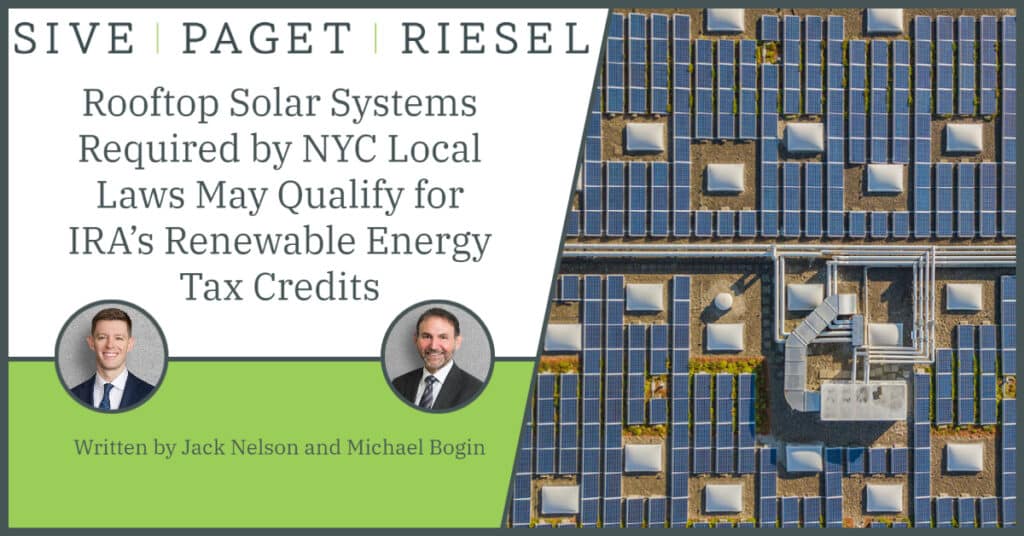Blog

Rooftop Solar Systems Required by NYC Local Laws May Qualify for IRA’s Renewable Energy Tax Credits
New York City local law requires new roofs (with some exceptions) to install a solar photovoltaic (PV) electricity generating and/or green roof system. While these requirements became effective in 2019, given the pace of construction in New York City, many of the roofs covered by the law have only recently been, or will soon be, installed. Meanwhile, the federal Inflation Reduction Act of 2022 (IRA) provides tax credits for qualifying renewable energy systems, including solar, provided that the projects come online after December 31, 2022, and that construction begins before January 1, 2025. Developers and property owners may be considering whether to install solar PV systems or green roofs to meet their obligations under local law or to take advantage of the availability of federal tax credits. Now is an opportune time to explore this convergence and how these laws interact with each other.
In 2019, the New York City Council passed Local Laws 92 and 94 as part of the Climate Mobilization Act (CMA). The CMA directs the City to reach carbon neutrality by 2050, in part through various policies and incentives targeted at improving energy efficiency in buildings. Effective November 15, 2019, Local Laws 92/94 require new buildings, new roofs resulting from the enlargement of existing buildings, and existing buildings replacing an entire existing roof deck or roof assembly to install a “sustainable roofing zone,” the entirety of which must be a solar PV electricity generating system, a green roof system, or a combination of the two (with some limited exceptions). Solar PV systems must have a capacity of at least 4 kilowatts (kW) to qualify under the law. If the 4-kW capacity minimum cannot be met, a green roof system must be installed instead, unless the roof is too steep.
Enacted last year, the IRA allows taxpayers to deduct a percentage of the cost of eligible renewable energy systems from their federal taxes through a Production Tax Credit (PTC) and/or Investment Tax Credit (ITC). The IRA extends the PTC and ITC through at least 2025, as long as projects are under 1 megawatt (MW) in size or meet prevailing wage and apprenticeship requirements. Qualified projects include multiple solar and wind technologies, geothermal, tidal, energy storage technologies, microgrid controllers, fuel cells, biomass, landfill gas, hydroelectric, marine and hydrokinetic projects, and interconnection costs. Further, although not the focus of this blog post, both the PTC and ITC may be subject to bonus credits, for projects achieving domestic content minimums, siting in energy communities, siting in low-income communities or on Indian land, and for qualified low-income residential building projects or economic benefit projects.[1] These tax credits are subject to the following requirements:
- The PTC is a 2.75 cent per kilowatt-hour (kWh) tax credit for electricity generated for the first 10 years of a qualifying system’s operation.
- The credit is available for renewable energy “produced by the taxpayer” from qualified resources, and “sold by the taxpayer to an unrelated person during the taxable year.” 26 U.S.C. § 45(a).
- Solar energy is included as a qualified resource. However, note that for solar facilities specifically, they must be “owned by the taxpayer.” 26 U.S.C. § 45(d)(4).
- The ITC is a percentage-based tax credit, amounting to 30% of a qualifying project’s total cost basis for a system installed during the tax year.
- Solar-generated electricity and energy storage technology both qualify for the credit, so long as “the construction, reconstruction, or erection . . . is completed by the taxpayer.” 26 U.S.C. § 48(a)(3)(B)(i).
- Likewise, installation of interconnection property also qualifies for the ITC, if “paid or incurred by the taxpayer.” 26 U.S.C. § 48(a)(8).
- Unlike the PTC, the ITC does not require that the facility be owned by the taxpayer.
A June 2023 web post from the U.S. Department of Energy’s Solar Energy Technologies Office states that only the incremental costs of a roof installation are eligible for the ITC, citing a 2015 IRS ruling that defines incremental costs as those which “exceed the cost of reroofing Taxpayer’s building with a non-[solar] roof allowed by local law.” Although at this time it does not appear that the preexisting legal obligations of Local Laws 92/94 would disqualify taxpayers from receiving the IRA’s renewable energy tax credits, this has yet to be explicitly addressed in proposed regulations or guidance from the IRS or the U.S. Treasury Department.
It remains to be seen whether forthcoming guidance or regulations will provide more clarity to taxpayers interested in taking advantage of these incentives in the IRA. The SPR Blog will continue to track these developments and provide updates and analysis.
[1] A May 2023 SPR Blog post summarized recent guidance from the IRS and the Treasury Department on the “energy communities” bonus credit.